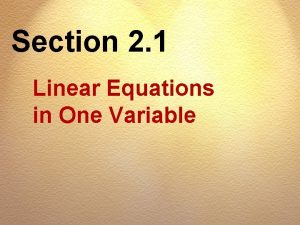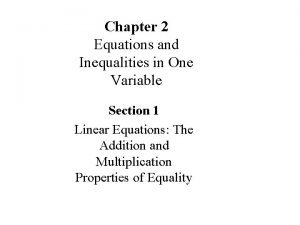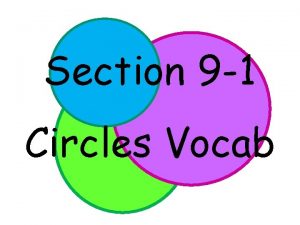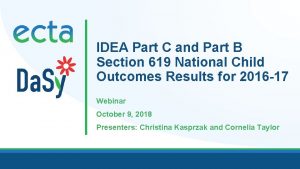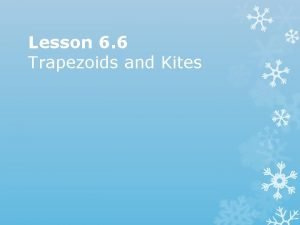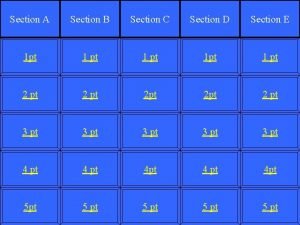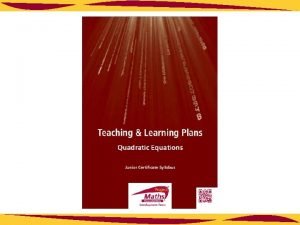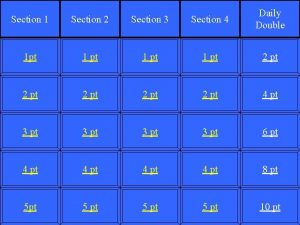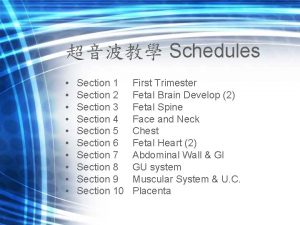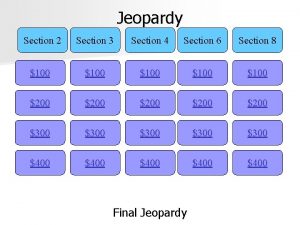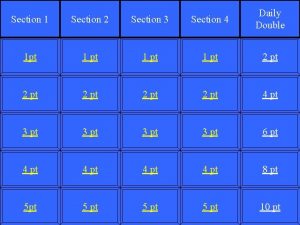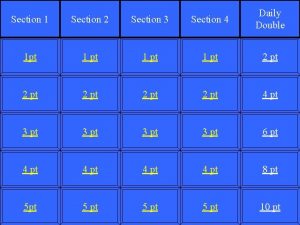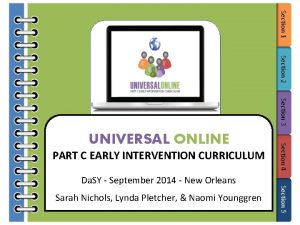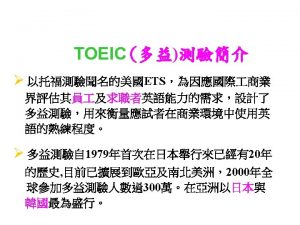Lesson 3 Section 9 2 part 1 Lesson



















- Slides: 19

Lesson 3: Section 9. 2 (part 1)

� Lesson 1: p. 546 #1, 2, 3, 6 -13 2. ) H 0: p = 0. 72; Ha: p ≠ 0. 72 where p = proportion of teens in Yvonne’s school who rarely or never fight with their friends. 6. ) H 0: σ = 10; Ha: σ > 10 where σ = standard deviation of the distance jumped by the ski jumpers. 8. ) The hypotheses are about the sample statistic. Also, we are only interested in a one-sided alternate hypothesis. H 0: p = 0. 37; Ha: p >. 37 10. ) The values in both hypotheses need to be the same H 0: µ = 1000 grams; Ha: µ < 1000 grams 12. ) (a) If the proportion of students at Yvonne’s school who say they rarely or never argue with friends is really 0. 72, there is a 2. 91% chance of getting a sample result 96 of 150 students. (b) Yes

� Lesson 2: p. 546 #15, 19, 20, 21, 23, 24, 25 20. ) (a) p = proportion of calls in which first responders are arriving within 8 minutes. H 0: p = 0. 78; Ha: p > 0. 78 (b) Type 1 error: The city concludes that the proportion of accidents with an appropriate response times has increased when it really hasn’t. Type II error: The city concludes that the population of accidents with an appropriate response time has not increased when it really has. (c) Type 1 error would be worse. The city may stop trying to impove its response times because they think they have met the goal, when in face they haven’t. More people could die. (d) Answers may vary. 24. ) Power = 0. 86

� Check conditions for carrying out a test about a population proportion. � If conditions are met, conduct a significance test about a population proportion.

� Confidence intervals and significance tests are based on the sampling distributions of statistics – both use probability to say what would happen if we applied the inference method many times. � In this section, we will focus on proportions.


� The test compares a statistic calculated from sample data with the value of the parameter stated by the null hypothesis. � Values of the statistic far from the null parameter value in the direction specified by the alternate hypothesis give evidence AGAINST Ho � To access how far the statistic is from the parameter, standardize the statistic. This standardized value is called the test statistic: � Test statistic = ______statistic – parameter___ standard deviation of statistic This tells us how far the sample result is from the null parameter value!! From this and using Table A, we will find the Pvalue!

� Recall Lamar’s � H 0: p = 0. 80 � Ha: p < 0. 80 claim that he is an 80% shooter. � In an SRS of 50 throws, the virtual player made 32. � (a) Check the conditions. � Random: We can view this set of 50 shots as a simple random sample from a population of all possible shots. � Normal: Assuming H 0 is true, p = 0. 80. Then (50)(. 80) = 40≥ 10 (50)(1 -0. 80) = 10≥ 10 � Independent: The outcome of each shot is determined by the computer’s random number generator, so observations are independent of each other (We do not need to check the 10% rule because we did not sample without replacement)

� Recall Lamar’s claim that he is an 80% shooter. �H 0: p = 0. 80 �Ha: p < 0. 80 � In an SRS of 50 throws, the virtual player made 32. � (b) Calculate the test statistic. �Test statistic = ______statistic – parameter___ standard deviation of statistic z = 0. 64 – 0. 80 0. 0566 z = -2. 83

� Recall Lamar’s claim that he is an 80% shooter. �H 0: p = 0. 80 �Ha: p < 0. 80 � In an SRS of 50 throws, the virtual player made 32. � (c) Find and interpret the P-value—draw the picture of the Normal curve and shade �Using Table A, we find the P-value is P(z≤-2. 83) = 0. 0023. �So if H 0 is true (Lamar is makes 80% of his free throws in the long run), there’s only about a. 0023 chance (or a 2 in a 1000) chance that the player would make as few as 32 out of 50 shots.

� STATE: �Hypotheses �Significance level �Define any parameters you use. � PLAN: �Choose and state the appropriate inference method (Here it’s a one-sample z test for p) �Check conditions. � DO: �Compute the test statistic. �Draw the curve, shade, and find the P-value � CONCLUDE �Interpret the results in context of the problem.

� Choose an SRS of size n from a large population that contains an unknown proportion p of successes To test the hypothesis H 0: p = p 0, compute the z statistic. mean of p hat = p (we use the proportion stated z= Sample in the null hypothesis) proportion Standard deviation of p hat (we use the proportion stated in the null hypothesis) � Find the P-value by calculating the probability of getting a z statistic this large or larger in the direction specified by the alternate hypothesis.

� On shows like American Idol, contestants often wonder if there is an advantage to performing last. To investigate this, a random sample of 600 American Idol fans is selected to view the audition tapes of 12 never-before-seen contestants. � For each fan, the order of the 12 videos is randomly determined. Thus, if the order of performance doesn’t matter, we would expect approximately 1/12 of the fans to prefer the last contestant they view. � In this study, 59 of the 600 fans preferred the last contestant they viewed. Do these data provide convincing evidence that there is an advantage to going last?

� In this study, 59 of the 600 fans preferred the last contestant they viewed. Do these data provide convincing evidence that there is an advantage to going last? �STATE: Hypotheses, Significance level, Define any parameters you use. �STATE: We want to test the following hypotheses at the significance level: H 0: p = 1/12 Ha: p > 1/12 Where p = true proportion of American Idol fans that prefer the last contestant they see.

� In this study, 59 of the 600 fans preferred the last contestant they viewed. Do these data provide convincing evidence that there is an advantage to going last? �PLAN: Choose and state the appropriate inference method, and Check conditions. �PLAN: If conditions are met, we will perform a one-sample z test for p. Random: A random sample of American Idol fans was selected, and the order of videos were viewed randomly as well. Normal: (600)(1/12) = 50 ≥ 10 and (600)(11/12) = 550≥ 10. Independent: It is reasonable to assume that there at least 10(600) = 6000 American Idol fans.

� In this study, 59 of the 600 fans preferred the last contestant they viewed. Do these data provide convincing evidence that there is an advantage to going last? �DO: Compute the test statistic and Find the Pvalue �DO: The sample proportion of fans who preferred the last contestant is �Test statistic: �P-value: P(z > 1. 33) = 1 – P(z≤ 1. 33) = 1 -. 9082 (From Table A) = 0. 0918.

� In this study, 59 of the 600 fans preferred the last contestant they viewed. Do these data provide convincing evidence that there is an advantage to going last? � CONCLUDE: problem. Interpret the results in context of the � CONCLUDE: Since the P-value is greater than (0. 0918 > 0. 05), we fail to reject the null hypothesis. There is NOT convincing evidence to conclude that there is an advantage to performing last in American Idol. � Another example in your book on pg. 553 and a Check Your Understanding on p. 555

� Just like confidence intervals, you can do significance tests in your calculator: � STAT TESTS option 5: 1 -Prop. ZTest � Type in the correct info: �Po is your null hypothesis �X is the # of “successes” in your sample �n is the sample size �prop is specifying the alternate �You can use Calculate or Draw—I like “Draw” since it will draw the curve and show you the shaded region as well as the statistics you need!

� Assigned reading: p. 549 -556 � HW problems: p. 562/#34 -37, 41, 43, 45 � Check answers to odd problems.
 Part part whole addition
Part part whole addition Part to part ratio definition
Part to part ratio definition Part part whole
Part part whole Technical object description example
Technical object description example Parts
Parts The part of a shadow surrounding the darkest part
The part of a shadow surrounding the darkest part Two way anova minitab 17
Two way anova minitab 17 Rstuv
Rstuv Section 2 topic 2 linear equations in one variable part 2
Section 2 topic 2 linear equations in one variable part 2 Vocab circle
Vocab circle Idea part b section 619
Idea part b section 619 What line types are usually omitted from sectional views?
What line types are usually omitted from sectional views? Revolved section in engineering drawing
Revolved section in engineering drawing Half section
Half section What is the definition of chemical potential energy
What is the definition of chemical potential energy Study guide chapter 10 section 1 meiosis
Study guide chapter 10 section 1 meiosis Unit 2 lesson 6 trapezoids and kites
Unit 2 lesson 6 trapezoids and kites 6-6 systems of linear inequalities
6-6 systems of linear inequalities Lesson 19 the acts of the apostles part 1
Lesson 19 the acts of the apostles part 1 Acts 19 1-6
Acts 19 1-6







